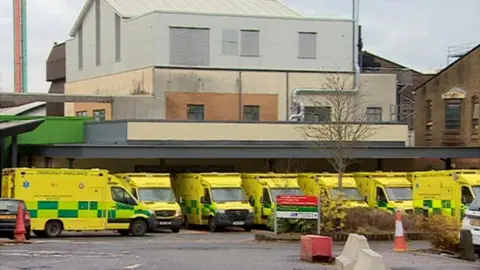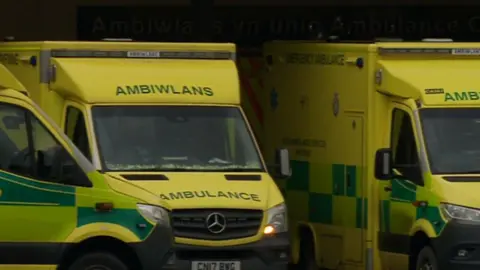NHS Wales: A&E record low performance as ambulance service struggles
 BBC
BBCAccident and emergency performance at hospitals in Wales is at a record low for the third month running, according to latest figures.
It comes as the Welsh Ambulance Service failed to meet its response time target for the first time in four years.
There were nearly 86,000 patients using A&E in Wales in November - 74.4% were seen within the four-hour target.
For ambulances, 61.4% of life-threatening red calls arrived within eight minutes. The target is 65%.
The figures also showed 5,890 patients spent 12 hours or more in an emergency care department in November, up 310 patients (5.6%) from October and an increase of 2,333 patients (65.6%) compared with November last year.
Official targets state nobody should be waiting that long in urgent care departments.
The Royal College of Emergency Medicine in Wales said it had "grave concern" about these longest waits.

For the four-hour target, the worst performing was Glan Clwyd Hospital, in Denbighshire, where only 57.5% of patients were seen within that time, followed by the Royal Gwent in Newport with 58.6%.
The overall figure for Wales was worse than October's figure of 75.4% and down 5.7 percentage points on the same time last year.
For the ambulance service, it was by far the busiest month on record for their most serious calls - with 2,914 categorised as red.
For the first time since the new system came in, in October 2015, the eight minute response time target was not met.
Management believe an update to call-handling practices this summer has had an effect and further work is being undertaken to understand why.
Jason Killens, chief executive of the Welsh Ambulance Service, said it had also faced some of its busiest months ever - and challenges with handovers at some hospitals.
"Our priority is always to respond to the sickest patient first," he said.
"Patients with less serious conditions, may regrettably wait some time and that's particularly true in the peak of winter. To keep those patients safe, we have more clinicians in our contact centres and out on the ground - and about 10% are dealt with safely by advice over the phone."
'You can't stop a tsunami with sand bags'
In Swansea, there were 7,116 patients who used the city's main emergency department at Morriston hospital in November - just over 62% were seen within the four-hour target, the third worst performance in Wales.
Consultant Mark Poulden, clinical lead, said they were constantly in a state of high escalation.
"We used to have days when we had a little respite and certainly over the summer months - but it appears the winter pressure is now year-round and it's gradually cranking up," he said.
"We're seeing the first few cases of flu and indications are we're expecting a severe outbreak. That hasn't hit and already we have patients in all our spaces and outside in ambulances we're unable to get into the department."

An acute GP unit (AGPU) is working with the Welsh Ambulance Service to try to relieve the pressures on Morriston.
Emergency call handlers can refer cases to a GP for assessment, before they are visited by a paramedic.
Dr Stephen Greenfield, who leads the AGPU service at Singleton Hospital in Swansea, said they looked at the detail of the calls and worked out the most appropriate method of help.
"We ring the patient and talk to them about what has happened, what their history is and discuss the best options available to them," he said.
"It might be that they then go to another hospital - rather than Morriston's emergency department - or that they still visit Morriston but are given taxi transport.
"We might get in touch with their GP surgery instead - it depends on the situation and what the patient is most comfortable with."
The aim is also to help free up ambulances to attend more urgent calls.
During a recent two-week period at peak times, the unit was able to provide other options in 71.4% of cases - a third of these involved not having to visit a hospital at all.
It also works with paramedics and is set to be expanded.
Dr Greenfield added: "When we work with paramedics who have visited someone, 83% of the patients don't end up in Morriston's emergency department, and 24% of these patients don't go to hospital at all."
Mr Poulden said such schemes would help but would not transform the system, and a radical rethink of the NHS and social care was needed, saying "you can't stop a tsunami with sand bags."
What has been the reaction?
Dr Jo Mower, vice president of the Royal College of Emergency Medicine in Wales, said she had witnessed admissions soar in her 15 years in the job and the increase in the longest waits was of "grave concern".
"We know that there is evidence that suggests that long waits in hospital corridors puts patient safety at risk. The general reduction of staffed beds across the NHS in Wales means that we cannot admit patients from the emergency department as quickly as we would like to, resulting in overcrowding, trolley waits, and corridor-based care."
'Incredible pressure'
Conservative health spokeswoman Angela Burns AM said: "If I was appalled at last month's figures, then frankly I am disgusted at these, which are set against the backdrop of lower attendance figures, so the Welsh Labour Government cannot argue that it was facing increased pressures."
Plaid Cymru health spokeswoman Helen Mary Jones AM called the figures "scandalous".
"The Welsh Government changed the way it calculated ambulance response times allegedly to more accurately reflect the performance of the service," she said. "It was suspected at the time that this was more about massaging the figures and now the new targets cannot be met".
The Welsh NHS Confederation - which represents health boards - said A&E units were under "incredible pressure" and it was increasingly clear that hospitals were treating an "unprecedented number of patients with more complex and serious health and care needs".
The Welsh Government said: "It is clear that pressures across the system, including increases in hospital outbreaks of flu and norovirus, have affected emergency care performance this month and it is disappointing to see the target for red ambulance calls missed for the first time," said a spokeswoman.
"However, despite the increase in demand, the average response in this category remained at six minutes and 39 seconds, and 73% of patients received a response in 10 minutes. We have also seen improvements in diagnostic and therapy test waiting times compared to October."
The latest monthly statistics also show the number of patients waiting more than nine months to start hospital treatment after referral from their GP - 21,145 - is the highest for nearly two years.
But the percentage of patients treated within the target time for cancer has increased.
